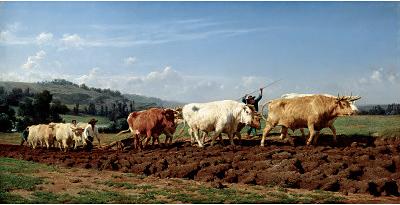Rosa Bonheur
French, 1822-1899PLOUGHING IN NIVERNAIS, 1850
SN 433, oil on canvas, 52” x102”
From "The Pages".
ARTIST:
Rosa Bonheur was one of the most famous women of her time, and one of the leading animal
painters of the 19th c. Her earliest training was received from her father, a minor
landscape painter & teacher, who encouraged her interest in art in general and in
animals as her exclusive subject. Even as a child she had kept a menagerie of animals
– on the 6th floor balcony of her parents’ Paris apartment. |
|
 |
As an adult she much admired Buffalo Bill, a sentiment he returned. He brought her an
American Indian outfit complete with bow and arrows when his Wild West Show came to Paris.
She painted him & his troupe at that time. Other fans were Queen Victoria & the
Empress Eugenie.
Her lifestyle was unconventional. She was a tiny, strong-willed woman who wore her hair
short, smoked cigarettes in public and visited the slaughterhouse to study animal anatomy.
For this work she wore men’s trousers – for which she was required to obtain
official authorization from the police!
For 50 years her companion was a childhood friend, Nathalie Micas. After Nathalie’s
death, her friend Anna Klumpke joined her at the Chateau de By for the last two years of
Rosa’s life. After Rosa’s death at 77, Anna wrote her biography.
While Bonheur was radical in her personal life, she was artistically conservative.
Photographic realism is the hallmark of her work, yet she rises far above mere
photographic representation. She was intelligent, conscientious, & hard working. She
believed in honesty in art & kept as close to nature as she could.
SUBJECT:
The subject is typical of the Realist interest in rural society, also manifested in the
description of oxen at work in George Sand’s popular novel of 1846, The Devil’s
Pond. It is a celebration of the nobility of animals’ – and the peasants’
– labor in the fields. Two teams of oxen, six to a team, are pulling wooden ploughs
guided by two farmers. The broad expanse of sky is treated with the light and clarity seen
in Dutch paintings, which Rosa had studied and copied in the Louvre as part of her
education – particularly the works of Paulus Potter, who specialized in cattle &
sheep.
PAINTING:
Oxen have never been painted with such conviction. The two teams move forward, slightly
uphill, with mute power as saliva drips from their mouths. The muscles, the shaggy texture
of fur…it’s all there. Notice that
they are not wearing yokes, their drivers using only voice commands. The land they are
ploughing is also depicted with such accuracy that one can almost smell the fertile soil
being turned in the spring afternoon;
grass grows in patches, weeds stick up here & there.
As for the human figures, note the details. Broad-rimmed hats bring welcome protection
from the sun. As the first driver walks alongside, his foot lifts out of his wooden shoe.
He raises his stick & the animals are responding in their own ways…one turns his
head away, the other lowers his head.
The first painting titled Labourage Nivernais was commissioned by the French government
after Bonheur’s painting of red oxen was shown in the Salon of 1848, where it won 1st
prize. The Labourage was completed & exhibited in the Salon in 1849; it can be seen
today in Paris, at the Musee d’Orsay. That and another (huge) painting entitled The
Horse Fair (now in the Metropolitan, NY) rocketed Rosa to fame. She became the first woman
to be inducted into France’s Legion d’Honneur, the highest honor France can
bestow. The medal was presented to her at her studio in 1865 by the Empress Eugenie.
The Labourage became so famous that she painted more than one…ours is a signed
variant done in 1850. The magnificent frame is original to it, and she was famous enough
that her name was prominently displayed at its top. Another variant hangs in the RW Norton
Gallery, Shreveport, LA.
HISTORIC CONTEXT:
In June, 1848, Paris was in violent political, economic, & social turmoil. Thousands
of wage laborers barricaded streets and thousands were injured or killed. Fear of its
spreading influence had an unsettling effect on people in France and Europe, and it was
reflected in their taste in art. The public yearned for he tranquility, stability, and
something reassuring. They found solace in their image of what they considered unchanging:
country life. In Labourage they see the sunny blue sky, the hills and moving oxen create a
comfortable flow across the canvas. There is harmony between man and beast.
Labourage Nivernais was sold in 1866, when French Salon paintings were in vogue, for
today’s equivalent of over $200,000. John Ringling, an admirer of Rosa Bonheur’s
work, purchased it for $230 in 1929. A vivid example of how art prices fluctuate with the
taste of the times. Today…who can guess what it is worth!
There is a Bonheur Museum in Fontainebleau, France, near her beloved forest.
Museum Label:
Plowing in Nivernais (Labourages Nivernais)
1850
Artist: Rosa Bonheur
French, 1822-1899, active in Paris and Fontainebleau
Oil on canvas, 52 1/2 x 102 in. (133.4 x 259.1 cm)
Bonheur was the most famous woman artist of her day and ranked as one of the leading
animal painters in the 19th century. The Ringling Museum painting is a replica with minor
variations of the canvas Bonheur sent to the Salon of 1849 after spending the winter
working from nature in the Ni vre region of central France. The painting won a gold medal
at the Salon. Inspired by the chapter from George Sand's rustic novel La Mare au Diable
(1846), the painting depicts oxen in a noble, heroic fashion amidst a fertile landscape
that extols the virtues of country life.
Bequest of John Ringling, 1936, SN433
ringlingdocents.org
|
